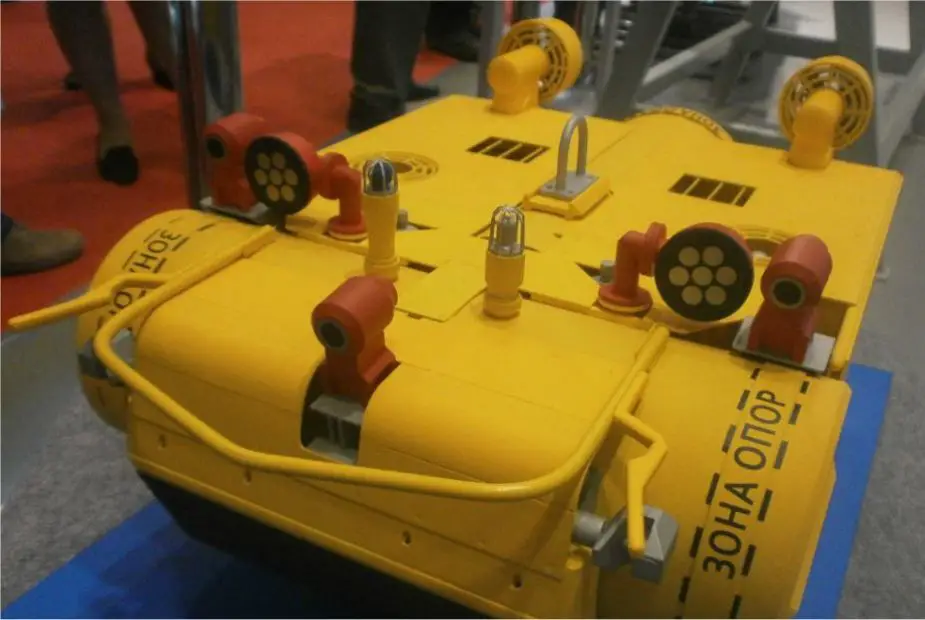Breaking news
Russian Navy tested new Unmanned Underwater Vehicles UUV Diamant and Alexandrite-ISPUM.
The Russian Navy tested new Unmanned Underwater Vehicles (UUV). An exercise to overcome a minefield was held in the Mediterranean Sea. The Dmitry Rogachev corvette of project 22160 and the Ivan Antonov minesweeper of project 12700 engaged Diamant and Alexandrite-ISPUM UUV to find mines that were destroyed by artillery fire. Experts believe the warships with the craft are irreplaceable in the troubled area, the Izvestia daily writes.
Follow Navy Recognition on Google News at this link
 UUV of the Alexandrite-ISPUM-E system. (Picture source Chinese Internet)
UUV of the Alexandrite-ISPUM-E system. (Picture source Chinese Internet)
The large-scale exercise to find and overcome conditional minefields also engaged the Admiral Grigorovich frigate of project 11356 and the Orekhovo-Zuevo corvette of project 21631. The Dmitry Rogachev and the Ivan Antonov had to make passes in the minefield for the group of warships.
Defense Ministry sources said the minesweeper engaged Diamant and Alexandrite-ISPUM craft. The Admiral Grigorovich and the Orekhovo-Zuevo sailed the cleared strip and destroyed the mockups of surfaced mines by artillery fire.
The mission was successfully fulfilled and the warships sailed to the assigned area without losses.
The exercise engaged the latest warships designed in the post-Soviet period. They are playing a major role in the Mediterranean, expert Dmitry Boltenkov said. “Russian warships in the region cannot operate without minesweepers. The situation is not simple and the civil war continues in Syria. The terrorists have not been finally defeated and can stage various surprises. There were cases of mining important sea routes in the Middle East. In particular, mines were laid in the Red Sea in 1984. Several vessels were damaged and crewmembers were killed and wounded,” he said.
The Soviet Mediterranean squadron obligatorily comprised minesweepers, which also operated as escort ships, Boltenkov said.
Mines are the most dangerous and cheapest weapons, expert Dmitry Kornev said. “Numerous modifications have been designed of late. Mines can be laid by warships and submarines, as well as aircraft. Smart munitions joined seabed and anchored mines. They can let small ships through and attack a big warship. They can also carry torpedoes which separate to hit a target away from the mine,” he said.
The Ivan Antonov Alexandrite-class minesweeper of project 12700 is made of fiberglass. It carries the Diamant which comprises two light boats with underwater robots operating in a range of 10 km and a depth of 100 meters. Mines do not react to the plastic hull and low-noise engine of the boats which conduct the search with sonars and magnetometers.
Alexandrite-ISPUM integrated system is in charge of mine detection. It comprises a remotely operated underwater craft which exposes suspicious objects in a range of 500 meters and a depth of 300 meters. It has a speed of 3-6 meters per second and can operate underwater in a rough sea of force 3.
Underwater robots place charges on exposed mines. They can tow them to shallow waters and explode. The remote mine clearance tactic reduces the risk to navymen to the minimum. Minesweepers properly interact with project 22160 corvettes. They were designed to defend vessels at sea and protect naval bases, the Izvestia said.
© Copyright 2020 TASS Navy Recognition. All rights reserved. This material may not be published, broadcast, rewritten or redistributed.


























